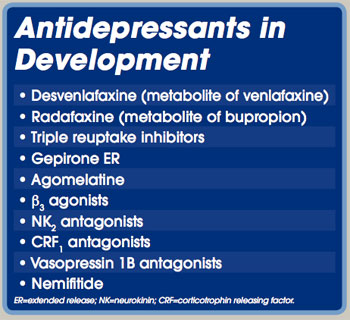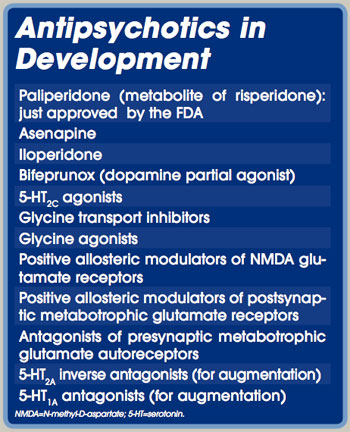Print Friendly
Trends in Psychopharmacology
Stephen M. Stahl, MD, PhD
Adjunct Professor of Psychiatry, University of California
San Diego
Antidepressants
New
psychopharmacologic treatments of interest include several late-stage products,
most of which have mechanisms similar to products already on the market. In the
area of depression, there are drugs that are active metabolites of known
antidepressants (desvenlafaxine and radafaxine), and drugs that combine actions
of known agents (ie, the “triple” reuptake inhibitors that block the
transporters for serotonin, norepinephrine, and dopamine). Triple reuptake
inhibitors may provide a therapeutic advance, especially for patients with
symptoms hypothetically linked to dopamine, such as cognitive problems, sexual
dysfunction, lack of motivation, and fatigue. Other agents in late-stage
development for depression include a controlled-release formulation of the serotonin
(5-HT)1A partial agonist, gepirone, and an interesting dual-action
agent, agomelatine, which combines agonist actions at melatonin 1 and 2
receptors with antagonist actions at 5-HT2C receptors. Agents
earlier in development for depression include the novel 3 agonists, neurokinin 2
antagonists, corticotropin releasing factor antagonists, vasopressin 1B
antagonists, an injectable pentapeptide, nemifitide, and many more.

Antipsychotics
In the area of schizophrenia, late-stage products include
new atypical antipsychotics, such as asenapine and iloperidone, as well as a
novel dopamine partial agonist, bifeprunox. Agents earlier in development for
schizophrenia include those working by non-dopaminergic mechanisms, such as
5-HT2C agonists; glycine transport inhibitors that boost co-agonist
glycine actions at N-methyl-D-aspartate
glutamate receptors; positive allosteric modulators of N-methyl-D-aspartate as well as post-synaptic
metabotrophic glutamate receptors; and antagonists of presynaptic metabotrophic
glutamate autoreceptors. There are also a number of augmentation strategies for
novel mechanisms to be added to atypical antipsychotics, including 5-HT2A
inverse agonists and 5-HT1A antagonists.

Disclosure: Dr. Stahl is a consultant
to, is on the speaker’s bureaus of, or receives grant/research support from
Acadia, Amylin, AstraZeneca, Biolaunch, Biovail, Bristol-Myers Squibb,
Boehringer-Ingelheim, Cephalon, CSC Pharmaceuticals, Cyberonics, Cypress, Eli
Lilly, Epix, Forest, GlaxoSmithKline, Janssen, Neurocrine, Neuromolecular,
Neuronetics, NovaDel, Novartis, Organon, Otsuka, Pfizer, Pierre Fabre, Sanofi,
ScheringPlough, Sepracor, Solvay, Shire, Somaxon, Tetragenix, and Wyeth.